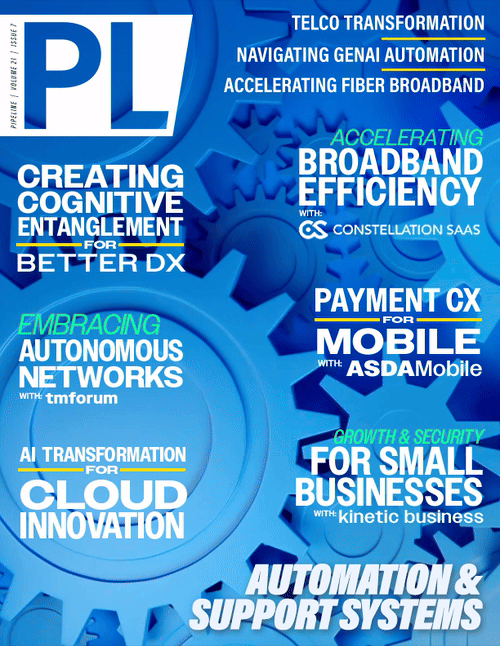Accelerating Broadband Efficiency
by Simplifying B/OSS Transformation

Being a Communications Service Provider (CSP) is an incredibly complicated business. Typical broadband operations can incorporate a proliferation of devices, service packages, network technologies, and support systems. In fact, a single service provider may have hundreds, if not tens of thousands, of intertwined systems. All of which need to operate harmoniously to meet customer demands. I’ve seen the system maps. They’re not pretty. Add to that an environment of constantly and rapidly evolving underlying technologies, mergers, acquisitions, regulatory frameworks, and things can get really ugly, fast.
This state of perpetual flux creates a challenging operational environment, but the multi-billion-dollar opportunity to own the customer relationship and the network that connects them makes it worth the effort. But, if you need an added incentive, federal funding supports the expansion of broadband services which is growing the market size and opportunity significantly. For example, the Broadband Equity, Access, and Deployment (BEAD) program in the United States is providing over $40B to do just that. Last month the United States Congress introduced a new bill, the Streamlining Program Efficiency and Expanding Deployment for BEAD Act,” dubbed “SPEED for BEAD,” to make the funding process even more efficient. The opportunity is clearly there, and it’s ripe for the picking. The only question that remains is how to overcome the challenges and complexity that plague so many fiber and fixed-wireless companies today.
Even well-run CSPs contend with tight profit margins and fierce competition – in an industry that is becoming increasingly commoditized. To succeed, they must not only transform but do so with efficiency at the forefront of their transformation. Fortunately, a whole host of technologies, solutions, and platform providers have risen to the challenge. But this can be a double-edged sword. Adding more systems into the mix, all of which must be customized and integrated, can add more complexity or worse, things can start to break. To tame the complexity, it takes more than best of breed products. It takes a seasoned team who have been there and done that. It takes a brain trust, backed by best-of-breed solutions, and who possess a deep understanding of CSPs unique business.
I recently had an opportunity to connect with the executive team at Constellation SaaS including Robert Ladd, Jay Carlson, Charlotte Field, and Del Guynes to discuss how broadband service providers can tame the complexity of modernizing their B/OSS systems and evolve their back office. And they know a thing or two, because they’ve seen a thing or two. We’ll get to that in a minute. Constellation SaaS is a newcomer that made its debut at Metro Connect in Fort Lauderdale, Florida in February of this year. Constellation SaaS was formed to combine a wealth of experience with large-scale transformation projects and best-of-breed telecommunications solutions. And they have one thing in mind: efficiency. Constellation SaaS solves the pain of scaling by harnessing over 100 years of collective telecom experience, with proven products to reduce the complexity of the back office and accelerate operational growth. But their secret sauce lies within their own unique experience. It encompasses over a century of successes and failures to develop best practices from which its customers can benefit.
“We’re experts at changing flat tires on moving cars,” Jay Carlson told Pipeline. “We know how to solve the problems broadband providers are facing because we’ve lived it, and we’ve developed a repeatable process that provides predictable outcomes.”
Connecting the Dots with Constellation SaaS
Shortly after 9/11, the State of Illinois was in a scramble. Illinois has one of the largest state governments and economies in the United States, dwarfing even that of some small countries. At the time, the state had nearly 50 state agencies, over 100,000 employees, and nearly 10,000 systems it had to unite to comply with emerging regulations and to create a common governance architecture and network infrastructure. And these weren’t just government offices such as the Department of Revenue and State Police. It also included energy and critical infrastructure, data centers, disparate networks, nuclear power plants, research institutions, and universities just to name a few. The state turned to Jay Carlson and Del Guynes who were not only able to rise to the challenge, but they were also able save the state nearly $3B in capital and operational expenses in the process.
Fast forward to 2016, when Charter Communications completed its acquisition of Time Warner Cable and Bright House Networks and combined them under the Spectrum brand. The acquisition formed one of the largest service providers within the United States. It also created a quagmire of networks and systems that had to be consolidated. This included multiple home-grown provisioning systems, Sarbanes–Oxley (SOX) compliant and non-compliant Enterprise Resource Management (ERP) systems, Business and Operational Support Systems (B/OSS), dozens of network and domain management systems and more. Even instances when the acquired companies were using the same systems, they were using them in different ways which further added to the complexity.
The responsibility to tackle this monumental challenge fell on the shoulders of the Charter Communications’ technology team. That team just so happened to include Robert Ladd, Jay Carlson, and Charlotte Field who served as Charter’s Group Vice President of IT Strategy & Planning, SVP Information Technology & Chief Information Officer, and Senior Vice President of Applications Platform Operations respectively. Ultimately, along with other professionals at Charter who have since joined Constellation SaaS, they were able to successfully and efficiently consolidate to just one provisioning system, a single SOX-compliant ERP system, a simplified B/OSS architecture, and flattened network infrastructure. This was no small task.



















